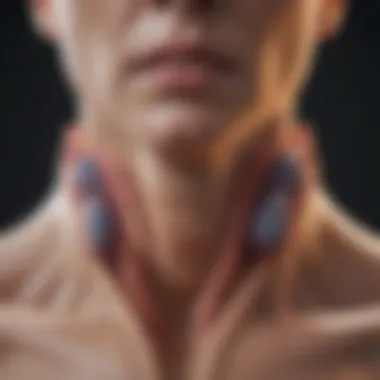Comprehensive Guide to Understanding Thyroid Cysts


Intro
Thyroid cysts are a common yet often misunderstood aspect of thyroid health. These fluid-filled sacs can arise for various reasons, and understanding their characteristics is crucial for both patients and healthcare providers. Often, they are discovered incidentally during imaging studies for unrelated health issues, which can lead to a flurry of questions about their implications.
Initially, one might wonder whether they are benign or indicative of something more concerning. The distinctions between the two can significantly affect treatment pathways and patient anxiety. This article aims to delve deeply into these complexities and elucidate the nuances that accompany thyroid cysts.
Background and Context
Overview of the Research Topic
Thyroid cysts have been a subject of medical scrutiny for decades. With the advent of advanced imaging technologies, their prevalence appears to be on the rise. These cysts can either be simple or complex, and their formation can result from various pathophysiological processes including but not limited to degeneration of thyroid tissue or the presence of benign or malignant tumors.
Understanding how these cysts form is just as important as knowing their potential health implications. In this exploration, we will navigate the labyrinth of clinical findings, diagnostic procedures, and treatment options available for affected individuals.
Historical Significance
Historically, the assessment of thyroid conditions, including cysts, has evolved significantly. In earlier decades, thyroid surgery was a common approach for most abnormalities noted in the gland. However, as research has progressed, the emphasis has shifted toward conservative management and monitoring for many patients.
"In the past, a visible lesion on the thyroid often meant surgery. Now, we focus on careful observation and informed decision-making based on diagnosis and imaging interpretation."
Medical professionals now favor a more conservative approach, relying on ultrasound imaging and fine-needle aspiration biopsy for evaluation. This shift has highlighted the need for continued research and education around thyroid health, ensuring better outcomes for patients.
Key Findings and Discussion
Major Results of the Study
The synthesis of current research indicates that 90% of thyroid cysts are benign, with only a small percentage evolving into malignant forms. The benign nature of many cysts often relieves patient concerns, yet almost half of these cysts will not require any treatment. Still, precise monitoring practices are essential to detect any changes over time.
- Benign cysts: Frequently, simple cysts cause no symptoms and can be left alone unless they grow or provoke discomfort.
- Malignant cysts: A minority require immediate intervention, including surgical removal if signifying potential thyroid cancer.
Detailed Analysis of Findings
In evaluating the treatments, there are myriad options ranging from observation to surgical intervention. Monitoring involves regular ultrasounds to assess for any changes in size or characteristics. If a previously benign cyst begins to grow or show irregularities, additional diagnostic procedures may be needed.
Medical professionals must educate patients about the differences between benign and malignant cysts. Some potential diagnostic tests include:
- Ultrasound: This imaging technique provides vital information regarding the size and structure of the cyst.
- Fine-needle aspiration biopsy: This allows for cytological analysis to determine cellular characteristics and guide treatment.
- Thyroid function tests: These blood tests help evaluate the overall functionality of the thyroid gland.
Constant advances in research are refining our understanding, promoting a culture of informed decision-making, and ensuring that patients bear a meaningful role in their care.
Preface to Thyroid Cysts
Thyroid cysts have become a focal point in the field of endocrinology. While they are often dismissed as mere curiosities, understanding these fluid-filled sacs can reveal much about thyroid health. The relevance of thyroid cysts cannot be understated; they hold significant implications for diagnosis and treatment of thyroid-related disorders. This section serves to establish a foundation for exploring the complexities of thyroid cysts, and it is crucial for both laypersons and professionals alike.
Defining Thyroid Cysts
A thyroid cyst is essentially a sac filled with fluid that develops within the thyroid gland, located at the base of the neck. These cysts can be classified as either simple or complex, based on their content and structure. A simple cyst appears as a uniform, fluid-filled reservoir, while a complex cyst may contain both fluid and solid components. It is important to differentiate between the two types, as they can signify different health implications.
An analogy can be drawn here: think of a simple cyst as a balloon filled with water, uniformly rounded and straightforward, while a complex cyst is like a balloon filled with water and marbles, presenting a more intricate and concerning structure. The definition is not just a technicality; it lays bare the necessity for accurate diagnosis through appropriate imaging techniques and biopsies. Understanding these definitions is the first step for healthcare professionals in determining a course of action.
Epidemiology and Prevalence
The occurrence of thyroid cysts is far from rare. Data suggests that up to 70% of individuals may have thyroid nodules or cysts detectable through imaging, yet many of these remain asymptomatic and go unnoticed. The prevalence varies significantly across populations and is influenced by factors like age, gender, and geographical location. For instance, women are more likely than men to develop thyroid cysts, clouding the data with a gendered dimension.
Various studies have indicated that the visibility of thyroid cysts tends to increase with age. The Northwestern University study, for example, reports that nearly half of individuals over the age of 50 will have a thyroid nodule or cyst. Regions with iodine deficiency also report higher incidences due to the lack of essential nutrients in the diet, which can lead to the formation of these cystic entities.
"Understanding the epidemiology of thyroid cysts not only enhances recognition but also drives public health initiatives focused on thyroid wellness."
In the end, the familiarity with the epidemiology of thyroid cysts serves to inform practitioners on assessment and management, allowing for early intervention in high-risk populations. Recognizing who is more likely to develop these cysts helps shape screening strategies and patient education accordingly.
Types of Thyroid Cysts
Understanding the various types of thyroid cysts is crucial for anyone looking to grasp the complexities of thyroid health. Each type possesses distinct characteristics that influence both diagnosis and treatment. Knowing these nuances helps in forming a more comprehensive picture of an individual's thyroid condition. By differentiating between simple cysts, complex cysts, and multinodular goiters, healthcare professionals can tailor their approach, ensuring better outcomes for patients.
Simple Cysts
Simple cysts are the most common type found in the thyroid and are generally benign in nature. These fluid-filled sacs vary in size, ranging from a few millimeters to several centimeters. They often show up during routine screenings and may not cause any noticeable symptoms. In most cases, simple cysts are filled with clear fluid, making them distinct from other types.
One of the appealing aspects of simple cysts is their usually harmless nature. They rarely lead to serious complications and often don’t require treatment unless they become particularly large or symptomatic.
Key characteristics include:
- Fluid-filled: They contain mostly fluid without solid components.
- Round shape: Simple cysts are typically round, easily identifiable via imaging.
- Benign: Unlike complex cysts, simple cysts are less likely to contain cancerous cells.
However, it is still important for individuals with simple cysts to seek regular monitoring, as changes could signal other underlying issues.
Complex Cysts
Complex cysts are a different ballgame. They can worm their way into complications due to their mixed composition, consisting of both fluid and solid components. This duality raises the stakes when it comes to diagnosis, as there is a higher likelihood of malignancy compared to simple cysts.


What makes complex cysts particularly intriguing is their diversity in appearance. They may appear as:
- Heterogeneous: Comprising various tissue types, which can complicate interpretation.
- Irregular shapes: Unlike simple cysts, their shapes can be more varied and less predictable.
- Thicker walls: Often they have irregularities or nodules along the edges.
Due to their potential association with malignancy, complex cysts usually warrant further evaluation through imaging techniques such as ultrasound, CT scans, or MRI. If there's suspicion of cancer, a biopsy may be recommended.
Multinodular Goiters
Multinodular goiters present an entirely different layer to the conversation. This condition involves an enlarged thyroid gland exhibiting multiple nodules or cysts. Unlike simple or complex cysts, multinodular goiters can cause various symptoms including discomfort, difficulty swallowing, and even a visible swell in the neck area.
- Nature of growth: Unlike isolated cysts, this condition is characterized by the presence of multiple growths that can vary in size.
- Functional aspects: Some nodules in a multinodular goiter may be hyperactive, leading to overproduction of thyroid hormones (hyperthyroidism) or, conversely, the gland may become underactive.
It's vital for medical professionals to assess multinodular goiters closely, as they may require different treatment approaches depending on whether the nodules are benign or malignant.
Recognizing the signs and symptoms associated with these thyroid conditions helps equip individuals with knowledge to engage in meaningful discussions with their healthcare providers. This ultimately leads to a more proactive approach to thyroid health.
Causes and Risk Factors
Understanding the causes and risk factors associated with thyroid cysts forms a cornerstone for grasping their nature and impact on health. These factors not only throw light on why some individuals may develop these cysts but also guide preventive approaches and the management of thyroid health. Delving into this part of the study is crucial; it links genetic predispositions, environmental interactions, and hormonal fluctuations, weaving a complex web that influences thyroid conditions.
Genetic Factors
Genetics plays a pivotal role in many health conditions, and thyroid cysts are no exception. A family history of thyroid disorders can increase the likelihood of cyst formation. Previous research suggests that specific genetic mutations elucidate an individual’s susceptibility to developing cystic structures in the thyroid. To illustrate, individuals with family backgrounds of Hashimoto’s thyroiditis or other endocrine disorders might find themselves at a heightened risk, suggesting a hereditary predisposition.
Moreover, understanding genetic factors allows medical professionals to tailor monitoring strategies for at-risk patients. The considerations should not stop at just noting the family tree; genetic testing may reveal predispositions that inform lifestyle changes or more vigilant health check-ups.
Environmental Influences
Environmental factors can significantly influence thyroid health. From the air we breathe to the food we eat, myriad elements play their part. One noteworthy point is exposure to certain chemicals. Substances such as perchlorate, a chemical often found in fertilizers and disinfectants, have been linked to thyroid dysfunction. These pollutants may disrupt hormone levels, indirectly promoting cyst formation.
Diet is another critical aspect when discussing environmental influences. A lack of iodine can lead to enlargement of the thyroid gland, potentially resulting in cyst development. This highlights the importance of adequate nutrition; ensuring an iodine-rich diet may offer a protective measure. Awareness of one's surroundings—such as avoiding areas known for environmental toxins—can act as a preventive strategy worth considering.
Hormonal Changes
Hormonal fluctuations exert a profound impact on thyroid function, thereby contributing to the development of cysts. Hormones such as estrogen have been shown to influence thyroid activity. For instance, during certain life phases such as pregnancy or menopause, women might experience changes in their thyroid function, which can lead to cyst formation.
A classic case is the increase in thyroid-stimulating hormone (TSH) during periods of hormonal changes, which could stimulate the growth of cysts. Given that thyroid health is closely tied to the overall endocrine system, monitoring hormone levels can provide insight into potential risks associated with cyst development. Staying vigilant during times of hormonal shifts could be key to preventing thyroid complications in some individuals.
"Knowledge of the underlying causes and risk factors associated with thyroid cysts empowers individuals to take proactive measures concerning their health."
Symptoms of Thyroid Cysts
Recognizing the symptoms of thyroid cysts is a vital component in navigating this complex health issue. Understanding what signs to look for can significantly impact early diagnosis and treatment options. This section delves into the common symptoms and how they can guide individuals on when to seek medical attention.
Common Symptoms
Thyroid cysts are often asymptomatic, meaning many individuals may not experience any noticeable signs. However, some may encounter specific symptoms indicating the presence of a cyst. These can include:
- Swelling or a lump in the neck: Patients might feel a fullness, especially in the front of the neck. This can be the most noticeable symptom.
- Pain or discomfort: Some individuals report discomfort around the cystic area, especially if it's large.
- Difficulty swallowing or breathing: In larger cysts, pressure on the trachea or esophagus can create challenges when swallowing or breathing.
- Changes in voice: Although less common, a cyst can potentially impact vocal cords, leading to hoarseness.
Listening to your body is crucial. If anything feels off, it’s worth paying attention to. Each symptom presents a unique set of considerations. For instance, people with small cysts may remain without noticeable symptoms for years, while larger or more aggressive cysts may announce their presence sooner.
When to Seek Medical Attention
Identifying when to consult a healthcare provider regarding thyroid cysts can be crucial. Here is when one should not hesitate to reach out for professional advice:
- Persistent or worsening symptoms: If swelling or pain persists over weeks, it’s wise to schedule an appointment.
- Rapid growth of a lump: Cysts that grow noticeably in a short time should be evaluated as they could indicate other underlying conditions.
- Presence of additional symptoms: If you experience a combination of symptoms such as hoarseness, breathing difficulties, or swallowing issues, get a professional opinion.
"Not every lump means trouble, but ignoring signs might do more damage than good."
Recognizing the nuances in these symptoms can empower individuals to take control of their thyroid health. Being proactive about changes in your body can lead to timely interventions, potentially reducing complications down the line. Each person’s experience might differ, but awareness remains a common thread in managing thyroid health effectively.
Diagnostic Approaches
In the realm of thyroid cysts, pinpointing a precise diagnosis is crucial for appropriate management and treatment. Accurate diagnostic techniques not only aid medical professionals in evaluating the nature of these cysts but also help in distinguishing benign from potentially malignant growths. Each method possesses unique strengths that contribute to a comprehensive understanding of a patient’s condition.
Imaging Techniques
Imaging forms the backbone of thyroid cyst investigation, enabling healthcare providers to visualize the thyroid and identify the characteristics of the cysts present. The three primary modalities include ultrasound, CT scans, and MRI, each serving a distinct purpose in this diagnostic landscape.
Ultrasound
Ultrasound is often the first-line imaging technique for evaluating thyroid cysts. Its non-invasive nature and ability to provide real-time images make it rather advantageous. A key characteristic of ultrasound is its effectiveness in assessing the internal architecture of cysts.
Its unique feature lies in the fact that it allows practitioners to determine whether a cyst is simple or complex. This differentiation can be vital, as simple cysts usually present less risk than complex ones. However, one drawback is that ultrasound cannot detect calcifications as effectively as other imaging options.
CT Scans
CT scans offer a more detailed view than ultrasound, especially when a thorough examination of the surrounding structures is needed. The ability of CT to produce high-resolution images means that practitioners can see the size and extent of cysts better. A hallmark of CT scans is their proficiency in detecting any abnormal growth that might signify malignancy.


However, the unique downside of CT scans is the exposure to ionizing radiation, which raises concerns particularly for frequent assessments. Additionally, interpreting these images requires a trained eye, making it slightly less accessible for initial evaluations than ultrasound.
MRI
MRI stands out for its exceptional contrast resolution. When it comes to soft tissue imaging, MRI can provide a detailed picture that other imaging methods may not achieve. The unique feature of MRI is its ability to differentiate cystic from solid lesions effectively, making it a beneficial choice in complex cases.
Yet, MRI is not often the first choice due to operational costs and longer scanning times compared to other imaging techniques. While it avoids radiation exposure, the logistical issues involved can limit its practical application.
Biopsy Procedures
When imaging results warrant further investigation, biopsy procedures can determine the nature of the cyst. Fine needle aspiration biopsy (FNAB) is the most common technique, as it uses a thin needle to extract fluid from the cyst for examination. This procedure often aids in identifying cancerous cells if present.
The importance of a biopsy cannot be understated: it clarifies a diagnosis that imaging alone may not confirm.
Blood Tests
Blood tests play a significant role as a complement to imaging and biopsy. These tests evaluate thyroid function, providing insight into hormone levels and aiding in the assessment of overall thyroid health. Often, specific tests of interest include the Thyroid-Stimulating Hormone (TSH) level, which assists in understanding the thyroid’s operational status.
Integrating both imaging and blood tests can enhance the diagnostic accuracy, leading to targeted treatment that aligns with a patient’s specific condition.
Differentiating Benign from Malignant Cysts
Understanding the difference between benign and malignant cysts is crucial when discussing thyroid health. Not all cysts pose the same risk, and recognizing their characteristics can significantly influence treatment options and patient outcomes. The distinction not only carries medical implications but also helps to alleviate patient anxiety and empowers them in making informed decisions about their health.
Characteristics of Benign Cysts
Benign thyroid cysts are generally non-cancerous and often asymptomatic. These cysts can occur due to various factors, including fluid accumulation or the presence of colloid, which is a gelatinous substance. Here’s a closer look at the hallmark features common to benign cysts:
- Size: Typically smaller than malignant cysts, benign cysts usually measure less than 3 centimeters.
- Composition: Most benign cysts are fluid-filled and can often be classified as simple cysts with clear, honey-like fluid.
- Borders: They have smooth, well-defined borders that are easy to identify during imaging studies.
- Imaging Characteristics: On ultrasound, benign cysts appear as anechoic (dark) areas, indicating they are filled with fluid. This clear distinction aids healthcare professionals in making a quick assessment.
"Identifying a benign cyst is often a matter of thorough imaging and clinical evaluation."
It’s important to note that even benign cysts necessitate monitoring in some cases, especially if there is a change in size or characteristics.
Indicators of Malignant Change
On the other hand, malignant cysts can pose significant health threats and require immediate attention. Malignancy can often be suspected based on certain warning signs. Recognizing these indicators is critical for timely intervention. Here are the common features suggesting a possibly malignant cyst:
- Size: Malignant cysts are often larger than 3 centimeters and continue to grow, raising red flags.
- Infiltrative Borders: Unlike benign cysts, malignant ones may have irregular or poorly defined borders, making them appear less contained.
- Internal Features: The presence of solid components or increased vascularity within the cyst on imaging can also suggest malignancy. The “lumpiness” seen in these cysts may indicate potentially harmful growths.
- Consistency: Malignant cysts may not only contain fluid but also solid and heterogeneous components, which can be detected during ultrasound examinations.
- Clinical Symptoms: Symptoms such as persistent pain, difficulty swallowing, or changes in voice can signal the need for further evaluation.
Differentiating these characteristics allows for tailored treatment plans. In some scenarios, further testing like biopsy or additional imaging is necessary to finalize the diagnosis and address any concerns.
Overall, the differentiation between benign and malignant cysts is not just about establishing a diagnosis. It serves as a pivotal step toward effective management, ensuring that patients receive the care they need at the right time.
Treatment Options
When dealing with thyroid cysts, the treatment route can widely vary, hinging on the type, size, symptoms, and whether any malignancy is suggested. It's like choosing a path in a thick forest; one misstep and you could end up in tangled underbrush. Understanding treatment options is essential not just for immediate solutions, but for long-term health as well. The correct approach can alleviate symptoms and ensure the best possible outcomes.
Monitoring and Observation
In many cases, especially when it comes to simple thyroid cysts, monitoring and observation are the first lines of attack. This technique involves regular check-ups and periodic ultrasounds to track changes in the cyst over time. A physician often adopts a ‘watchful waiting’ strategy, particularly when the cyst exhibits no troubling symptoms or signs of malignancy.
Why is this approach important?
- Reduced Anxiety: Many patients worry excessively about their cysts. Knowing that their health is being monitored can relieve some of that stress.
- Avoid Unnecessary Procedures: If a cyst isn't causing issues, opting for observation means that patients can skip invasive procedures.
- Catch Changes Early: Regular monitoring can catch any changes in size or characteristics early, allowing for swift action if needed.
There's an adage, "Out of sight, out of mind," but in this case, monitoring creates awareness rather than neglect. Physicians make educated decisions based on the cyst's behavior, which can help save a patient from more serious treatment later on.
Medications
Although there isn't a one-size-fits-all pill for thyroid cysts, certain medications can be administered to address symptoms if they arise. Hormonal treatments can sometimes assist in managing the effects of any underlying thyroid issues impacting cyst growth. For example, prescribed thyroid hormone replacement therapy might be suggested when the patient has hypothyroidism associated with thyroid cysts.
Key Considerations when it comes to Medications:
- Potential Side Effects: Each medication can come with its bag of tricks as far as side effects, which is something to keep in mind.
- Patient Adherence: It’s vital for patients to regularly take their medication and follow their doctor's advice to keep thyroid levels in check. If not, risks may arise that could worsen their condition.
- Periodic Evaluation: Regular evaluations are necessary to determine if medication remains effective and suitable for the patient.
It's crucial to remember that anyone using medications should be in close touch with their healthcare provider. "A stitch in time saves nine" might well apply here, allowing timely adjustments to keep health on track.
Surgical Interventions
When monitoring fails to yield favorable results or if a cyst is suspected of harboring malignancy, surgical intervention may become necessary. There are two prominently discussed options: aspiration and full surgical removal.
- Aspiration: This procedure involves inserting a needle into the cyst to drain excess fluid. Sometimes, this is a temporary fix; cysts can refill. However, it's less invasive and can provide immediate relief from symptoms.
- Surgical Removal: In cases where malignancy is confirmed or suspected, removing the cyst entirely may become the best option. This is the more invasive route but ultimately provides peace of mind and allows for a detailed examination of the cyst tissue.
When should one consider surgery?
- Suspicious Findings: If imaging shows features that raise red flags.
- Persistent Symptoms: When a cyst causes pain or difficulty swallowing.
- Growth Over Time: If there's a noticeable increase in size.
Both choices carry their risks, and patients must engage in thorough discussions with their healthcare teams.


Important Note: Always seek a thorough evaluation when dealing with thyroid cysts, as proactive measures can lead to better outcomes.
In summary, whether it's choosing to monitor, opting for medication, or considering surgery, taking informed steps concerning treatment options is vital for maintaining thyroid health. Decisions should always be guided by a qualified healthcare provider, ensuring a tailored approach that fits the individual patient's needs.
Complications and Prognosis
Understanding the possible complications and general prognosis associated with thyroid cysts is vital for anyone affected by this condition. These factors not only inform patients and healthcare practitioners about the potential risks but also guide decision-making concerning treatment and management. Knowing what to expect can empower individuals, giving them a clearer path forward in their healthcare journey.
Potential Complications
Thyroid cysts, while often benign, can lead to a variety of complications that need consideration. Recognizing these complications is key to early intervention. Here are some issues that may arise:
- Compression Symptoms: Large thyroid cysts can exert pressure on surrounding structures. This pressure may lead to breathing difficulties, swallowing problems, or even changes in voice due to compression of the trachea or esophagus.
- Hemorrhage and Pain: In some instances, a cyst may bleed internally. This hemorrhage can cause acute pain and require immediate medical attention. If an individual begins experiencing sudden neck pain, a prompt evaluation will be necessary.
- Potential Malignancy: A small percentage of thyroid cysts can harbor malignant cells. While generally unlikely, especially for simple cysts, it becomes crucial to monitor changes in size or characteristics closely. An increase in size could necessitate a reassessment of the diagnosis.
"Monitoring thyroid cysts is critical. Regular check-ups can often prevent complications before they escalate."
Careful assessment through imaging and possibly biopsy can help ascertain the nature of a cyst, guiding management choices and minimizing risks.
Long-Term Outlook
The long-term outlook for individuals with thyroid cysts largely depends on several factors including the type of cyst, its size, and whether it exhibits any concerning characteristics. Most people with simple cysts can expect a favorable prognosis with regular monitoring. Here’s a breakdown of potential scenarios:
- Benign Simple Cysts: They typically require minimal intervention and may resolve on their own. Regular ultrasounds often show no significant change over time.
- Complex Cysts or Nodules: These may demand a more vigilant approach. Patients may need follow-up imaging and possibly biopsy to confirm the absence of malignancy. Even then, many complex cysts are still benign and manageable with proper care.
- Malignant Changes: In cases where malignancy is detected, the prognosis can vary widely based on the cancer type and stage. Timely diagnosis and treatment can significantly improve outcomes. Surgical intervention may be necessary, leading to further comprehensive management post-surgery.
Thyroid Cysts and Related Conditions
The relationship between thyroid cysts and related conditions like Hashimoto's thyroiditis and thyroid nodules is significant in understanding the broader implications of thyroid health. This section focuses on how these conditions interplay with thyroid cysts, the potential risks they pose, and the impact they can have on overall thyroid functionality. Grasping these connections is crucial for students, researchers, and professionals who are keen to enhance their knowledge in the field of endocrinology.
Hashimoto's Thyroiditis
Hashimoto’s thyroiditis is an autoimmune condition wherein the immune system mistakenly attacks the thyroid gland, leading to chronic inflammation and often resulting in hypothyroidism. This inflammation can foster the development of thyroid cysts, amplifying the importance of monitoring for patients diagnosed with Hashimoto's.
Patients with Hashimoto's often present with a goiter, which in itself can lead to the formation of thyroid cysts as the gland becomes enlarged. As the immune system disrupts normal thyroid function, patients must remain vigilant. Here are some vital points to consider:
- Inflammatory Background: The inflammation caused by Hashimoto’s not only affects the thyroid but can also contribute to the environment in which cysts may form.
- Symptoms Overlap: Common symptoms like fatigue and weight gain in hypothyroidism can be overshadowed by the presence of cysts. This can complicate diagnosis and lead to delayed treatment.
- Surveillance Needs: Regular monitoring via ultrasound may be needed for individuals with this condition, as the risk of developing cysts and nodules increases.
Understanding the intimate connection between Hashimoto's thyroiditis and thyroid cysts allows for more comprehensive patient care plans.
Thyroid Nodules
Thyroid nodules are often found during routine examinations and can vary in nature—some are fluid-filled, while others might be solid. The interesting thing is that thyroid cysts themselves can sometimes be a form of a nodule, characterized predominantly by fluid content. So understanding the differences and similarities can be quite beneficial.
Here's what we know:
- Assessment Importance: Thyroid nodules, especially when solid, warrant careful evaluation since they can contain malignant characteristics. This is crucial for patients with pre-existing cysts, as they need to be aware of the potential transformation into something more serious.
- Differentiation Techniques: Ultrasounds can help to differentiate between benign cysts and nodules requiring further investigation.
- Impact on Thyroid Function: Nodules can affect hormone production, leading to conditions like hyperthyroidism or hypothyroidism based on their composition.
In summary, understanding thyroid cysts in the context of related conditions like Hashimoto's thyroiditis and thyroid nodules not only aids in recognizing symptoms but also enhances the ability to formulate more effective treatment plans. Staying informed about these interrelations plays a crucial role in the proactive management of thyroid health.
Lifestyle Considerations
When it comes to managing thyroid cysts, lifestyle considerations play a pivotal role. While medical intervention is crucial, the way one approaches daily life can significantly impact overall thyroid health. It's much like tending to a garden; without the right care and attention, even the healthiest plants can wilt. Here, we’ll delve into two main aspects that are critical for those dealing with thyroid issues: dietary recommendations and stress management.
Dietary Recommendations
Food can be a powerful ally or a subtle foe. A well-rounded diet is essential for optimal thyroid function and can alleviate complications associated with thyroid cysts. Here are some vital recommendations:
- Go for Iodine: The thyroid gland requires iodine for hormone production. Including iodized salt, seaweed, and fish can support healthy thyroid function. However, balance is key. Too much iodine might be counterproductive for some individuals.
- Opt for Selenium-Rich Foods: Selenium helps in the conversion of thyroid hormones and also offers antioxidant properties. Foods rich in selenium include Brazil nuts, sunflower seeds, and fish.
- Maintain a Balanced Diet: Focus on incorporating whole grains, lean proteins, plenty of vegetables, and healthy fats. Foods like berries and leafy greens not only provide nutrients but also combat inflammation.
- Limit Goitrogenic Foods: For individuals sensitive to these substances, it might be wise to limit raw cruciferous vegetables like broccoli and kale, as they can interfere with iodine uptake if consumed in large amounts.
- Stay Hydrated: Drinking sufficient water is often overlooked but is vital for metabolism and overall health.
Adopting these dietary practices can assist in maintaining a balanced hormonal environment for the thyroid. It’s important to note, however, that individual needs can vary. Consultation with a healthcare professional is recommended before making any significant dietary changes.
Thyroid Health and Stress Management
Stress and thyroid health are inextricably linked. Chronic stress can lead to hormonal imbalances and exacerbate thyroid-related issues. Here are ways to manage stress effectively:
- Engage in Regular Physical Activity: Exercise can help reduce stress levels while improving blood circulation. Going for a brisk walk or any chosen exercise can be beneficial.
- Practice Mindfulness Techniques: Consider incorporating mindfulness practices such as meditation, yoga, or deep-breathing exercises into your routine. These methods can promote relaxation and emotional well-being.
- Establish a Routine: Having a daily routine can provide structure and reduce stressors. Keeping regular sleeping hours, meal times, and work schedules can be surprisingly effective.
- Create a Support System: Surround yourself with friends or family who provide understanding and encouragement. Sometimes, just talking about problems can lighten the load.
- Make Time for Hobbies: Engaging in activities you enjoy can serve as a great outlet for stress relief. Whether it is painting, writing, or gardening, prioritizing leisure time is essential.
"An ounce of prevention is worth a pound of cure." - Benjamin Franklin
By adopting these proactive measures, individuals can empower themselves in their journey towards managing thyroid cysts.
Finale
Understanding the complexities of thyroid cysts is critical for both medical professionals and individuals facing this common condition. This article emphasizes the dual importance of recognizing the nature of these cysts, as well as the implications of their presence in the thyroid gland. Notoriously subtle, thyroid cysts can vary immensely in their characteristics, and distinguishing between benign and malignant forms is essential. The insights gleaned here not only illuminate treatment pathways but also highlight the need for ongoing monitoring and evaluation.
Summary of Key Points
The key messages from this comprehensive analysis can be summed up as follows:
- Definition and Types: Thyroid cysts can be classified as simple or complex and are often seen in multinodular goiters.
- Symptoms and Diagnosis: Many cysts are asymptomatic; however, some may present symptoms that warrant medical attention. Various diagnostic methods, including imaging and biopsy, help determine the nature of the cyst.
- Treatment Options: Depending on whether the cyst is benign or malignant, management approaches can range from careful observation to surgical intervention.
- Complications and Prognosis: Understanding potential complications helps in planning treatment and setting reasonable expectations for recovery and management.
- Lifestyle Considerations: Diet and stress management also play a pivotal role in thyroid health, influencing overall well-being.
Future Directions in Research
Looking forward, research into thyroid cysts is essential for advancing our understanding and treatment options. Areas worthy of exploration include:
- Genetic Research: Investigating genetic markers that may predict the likelihood of cyst formation or progression towards malignancy.
- Innovative Imaging Technologies: Development of new imaging techniques that can improve diagnostic accuracy and reduce the need for invasive procedures.
- Longitudinal Studies: Conducting studies that follow patients over extended periods to assess the long-term outcomes of different treatment strategies.
- Holistic Approaches: Exploring the effects of lifestyle changes, such as diet and stress reduction, on the development and management of thyroid cysts.
- Patient Education: Increasing awareness among patients about what thyroid cysts are and when to seek help can improve early diagnosis and treatment.
The exploration of these avenues will not only enhance clinical practices but also empower individuals with better knowledge and resources to manage their thyroid health. Ultimately, a comprehensive understanding of thyroid cysts paves the way for improved patient outcomes and informs ongoing discussions in the field of endocrinology.







